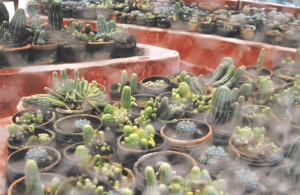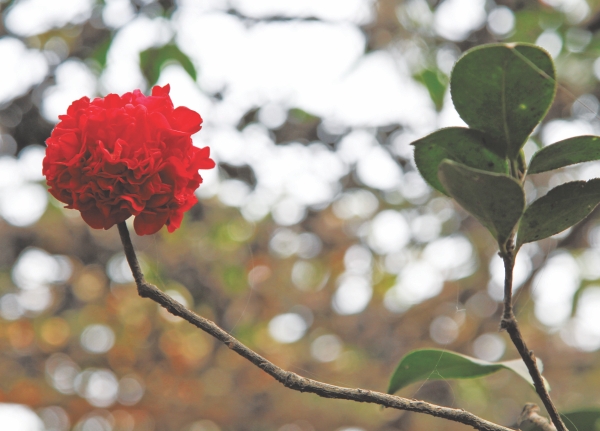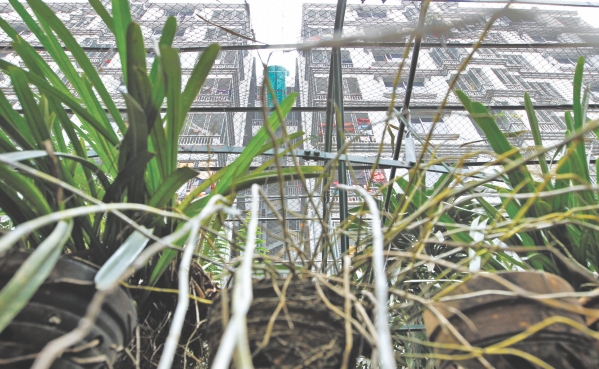| Home - Back Issues - The Team - Contact Us |
 |
| Volume 11 |Issue 06| February 10, 2012 | |
|
|
Cover Story
A Passion Turned into Treasure The Baldah Garden, Narendra Narayan Roy Chaudhury's dream child, fights everyday for a ray of sunlight, a little more space to breathe and a large dose of love to keep the weeds away Tamanna Khan Treasures are usually hidden in the most unexpected places. So is Baldah Garden, concealed from sight amongst old Dhaka's maze-like streets and crammed high-rises. It is in fact difficult to understand the rationale behind Baldah Garden's location in Wari. A peek into history explains it all.
Baldah Garden's beginning coincided with the time when Dhaka was being prepared as the capital of the newly made British Indian province, East Bengal and Assam. In 1909, Robert Louis Proudlock, the keeper of the Royal Botanical Garden at Kew, London, was summoned to Dhaka to design Ramna Garden in the heart of the city. During the same period, Narendra Narayan Roy Chaudhury, a self-driven nature-lover, planted his own Garden of Eden right in his backyard. Chaudhury, the adopted son of Harendra Narayan, zamindar of the Baldah estate in Gazipur district, was well educated in English, Arabic, Persian and Sanskrit. Unlike many other affluent landlords of the early twentieth century Dhaka, Chaudhury was progressive-minded and a connoisseur of art and literature. Although he wrote many poems and plays, his passion for gardening eventually made him a legend. According to historian Muntasir Mamun's “Smriti Bismritir Dhaka (Part-2)”, Chaudhury would go through nursery catalogues and order plants from different countries of the world. According to Mamun's account, Baldah has plants from around 50 different countries of the world.
Named after the Greek god Cupid's wife, Psyche, the first of the two gardens of Baldah, was built in the land adjacent to Chaudhury's resident “Culture” at Wari. After passing a number of tests to prove her love for Cupid, Psyche, which means soul, was given the gift of immortality by another god, Jupiter. Time has proven the justification of the name. Psyche, covering 100 x 45 metre area, has an impressive collection of rare cactus along with 450 species of other plants, mentions Mokaram Hossain, secretary general of Tarupallab, a nature-enthusiasts' organisation. This portion of the garden, which is reserved today for research and academic works, has water tanks for aquatic plants, a shade for aloe vera, different houses for orchid and cactus, a potting house and shades. A pyramid shaped house stands in the middle of the lawn at the back of the office building in Psyche. Rare cacti from different parts of the world adorn the shelves of the pyramid, giving the illusion of a cactus hill. At the far back, on the southern boundary of Psyche, stands yet another of Chaudhury's architectural ventures – a shade for ferns covering an artificial hillock with a cave underneath.
Shamshul Haque, who worked as the Botanist at the Baldah Garden from 1998 to 2003, was told by senior locals that Chaudhury had, in fact, designed the garden, replicating the shapes of different musical instruments. This may be true as a look at the layout of the two gardens of Baldah gives the impression of different musical instruments such as the harmonium, sitar and so on. Among the prizes of Psyche are rare water lilies including the Victoria Amazonica, more commonly known as Amazonian Water Lily. With its large leaves that can grow upto three metres in diameter, Victoria Amazonica, can even hold an adult human, when the weight is spread evenly on its delicate surface. Named after Queen Victoria, this plant is native to the shallow waters of the Amazon River basin in South America. The seeds germinate towards the end of winter and the saplings are planted during summer, informs Hossain adding the best time to go see the Amazonian Lily at Baldah is during the rainy season. Along the lily tanks, varieties of Egyptian papyrus, the plant that played an important role in recording the history of human civilisation, sways in the light breeze of a waning winter. Interestingly, bhojpatra, the tree that had helped record the history of this region also stands tall within Psyche's boundary. The off-white paper like bark of the bhojpatra, a Himalyan variety of birch, is used even today inside amulets, informs Mohammad Dulal Hossain, one of the maintenance workers of the garden.
“The acokanthera spectabillis with small white flowers was used by the British Raj to poison their arrow heads,” Dulal Hossain says pointing at the tree. Likewise, he shows another tree that is used for making medicine for cholera. Shamshul Haque, however, notes that while selecting and planting trees in his garden Chaudhury emphasised more on its beauty and the rare varieties rather than on the medicinal value of the plants. “Most of these plants came from countries that were in the British shipping routes of that time (twentieth century),” he mentions. After the completion of Psyche in 1936, Chaudhury began to think of his project in a different dimension. Another place was needed to ensure the growth of the soul that Psyche held and he ventured into creating Cybele. Named after the Anatolian form for Mother Earth, Cybele became the centre for experimentation and propagation of different species of plants brought from foreign soil. Cybele, with 136x76 metres of almost rectangular land, is open to visitors.
The attractions of Cybele include the path that directly leads to the northern end of the garden with tall trees providing a canopy all along. Joy house, the Shankhnad pond and the sun dial are some of the man-made beauties of Cybele. However, the most impressive are the rose beds and the camellia house. The camellia of Cybele blooming in four different shades once inspired the great poet Tagore to write his famous poem, Camellia. In 1938, Chaudhury had bought this portion of the land, right across from his own house, from Dhaka's renowned Shankhanidhi merchant family. He was joined by another enthusiast, Amrita Lal Acharya, son of Akhil Chandra Chakraborty, who assisted Proudlock in the Ramna Garden project. Acharya, a hard-core nationalist, dedicated his life in the work of the garden. Even after Chaudhury's death in 1943, he continued to take care of the garden despite financial constraints and red tape of the bureaucracy.
According to Muntasir Manum's narration, Chaudhury had died suddenly of a broken heart after his only son was brutally murdered in his own residence at Wari, allegedly by Chaudhury's second wife. As a result of his sudden death, the garden was taken under a trust controlled by the Calcutta High Court. Between 1951 to 1962, the garden was under the supervision of Pakistan government's Court of Wards. In 1962, the Forest Department was given charge of the garden. “Baldah in fact is the base garden of Botanical Garden,” explains renowned botanist Professor Dwijen Sharma, referring to the National Botanical Garden at Mirpur, which was started in 1962. He mentions that many saplings and seeds have been taken from Baldah and planted in the Botanical Garden. “If people do not see a variety of plants how would they know about their existence?” he asks explaining the importance of the rare plants of Baldah and its role in building the national garden as well as its academic value to students of Botany. Unfortunately, the records that once documented the total number of plants in Baldah, their traditional and scientific names, genus, species and country of origin, have been lost. The checklist for identifying the trees has not been preserved, says Mokaram Hossain. He assumes that Acharya probably had those documents which went missing after his death in 1983. In fact, many plants in the garden cannot be identified today, their label lost in the wraps of time. Ironically, no attempt has ever been taken to even record the varieties. Shamshul Haque, during his tenure as botanist, however did make a list of plants in Baldah; his only reference at that time being a 1975 survey of the garden by the Forest Department. His report prepared in the year 2002 shows 112 different plant families, 412 genus and 700 species in Baldah Garden. One of Baldah's main problem is that it does not have a curator. Ruhul Amin, Director of National Botanical Garden, Mirpur Dhaka, says, “A curator can use his expertise in artificial propagation or creating the next generation of plants. Unfortunately, that position has been vacant since 1995.” Amin claims that they have not been able to find any qualified person for this position. Baldah, now a satellite unit of the National Botanical Garden, does not have a separate budget. “At present, Baldah has eleven staff members— a forester, a forest guard and the rest are gardeners or maintenance workers,” informs Amin. Dulal Hossain, while cleaning the lily tanks laments that Baldah is heavily understaffed. “During Babu's (Narendra Narayan Chaudhury) days, 40 people used to work in this garden,” he says.
The ticket system at Cybele has been outsourced. However, the income is barely enough to meet the maintenance cost let alone improvement. Amin informs that tender for soil, organic and chemical fertilisers and earthen pots are called for both gardens and Baldah receives a proportionate share. He admits that the pot, orchid and cactus houses require renovation and paint; some portions need fencing; other repair jobs are long overdue. Amin however says that a proposal for a budget of four crore eleven lakh taka has been submitted at the ministry for development and renovation work at Baldah. Amin however says that there is no scope to expand or plant new trees in Baldah as it is becoming difficult to ensure the survival of the existing ones. “The space is crammed plus the high rises surrounding the garden hardly allows sunlight to enter,” he adds. Dulal Hossain shows the garbage, thrown from the surrounding high rises, strewn on the grilled-roof of the fern house. “The trees get only the midday sun. Even the sun dial does not work because of the shadows from the buildings,” he complains. Baldah's problems do not end here. Shamshul Haque explains how during the rainy season, water logging kills the plants. “When the garden was established, the surrounding areas were vacant. Later when the high-rises were built, each developer raised the base of the building. But it is not possible to raise the garden,” he says. It would have been possible to add earth and raise the garden as well, but that would have destroyed the plants, Haque adds. A drain pipe was installed underground to carry the extra water. Unfortunately, during the rainy season the main sewer becomes jammed and the dirty water overflows and floods the garden. “Even when the water recedes the sludge stays and fungi forms on the stems harming the plants,” adds Dulal Hossain. Three young men taking pictures of flowers at Psyche share their feelings for the garden. One of them, Samrat, a Wari resident living in one of the high rises, says, “Yes, we do have a lot of mosquitoes. But this garden provides relief for the eyes and a cool soothing breeze. Every time, I pass the adjacent Narinda road, I can feel the freshness in the air.” Unfortunately, the ever encroaching high rises continue to proliferate blocking the sunlight and suffocating this remarkable piece of paradise in the middle of this unattractive city. As Amin, Hossain and Haque opine, the buildings surrounding Baldah cannot be demolished, but the passion behind the garden however, can be a source of inspiration to others like Chaudhury who had a green thumb and extraordinary vision, to create more gardens like Baldah in other parts of the city or beyond. As Mokaram Hossain suggests, Baldah can be replicated elsewhere in a more spacious place, keeping Narendra Narayan Roy Chaudhury's original design and objective in mind. Otherwise, we will deprive the coming generations from the wisdom, beauty and secrets that the plant kingdom holds. Copyright (R) thedailystar.net 2012 |
||||||||||||||||||||||||










